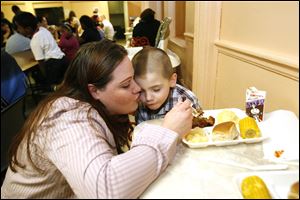
Count of Toledo's homeless begins
1/26/2010
Jennifer Shuff encourages her son, Kaiden Kennedy, to eat at the Family House shelter on Indiana Avenue. She and her husband, Brent Shuff, and their four children are newly homeless.
Rarely do homeless advocates pray for snow to get dumped on the homeless. But that's what Ken Leslie and his band of volunteers were doing Monday night when most of metro Toledo went to bed.
You see, a fresh blanket of snow helps track more than deer.
It also helps track humans - in this case, an often overlooked subpopulation of have-nots who live under bridges, in vacant buildings, and wherever else they can get some warmth and privacy for free.
For four hours this morning, starting at 12:01 a.m., Mr. Leslie was scheduled to be one of about 20 volunteers looking in the city's nooks and crannies for its forgotten people.
Counting homeless people who stay in area shelters is hard enough, given how life's circumstances prompt them to move about.
It's even harder for four teams approaching people in the dark who don't want to be disturbed.
"Every single person matters," said Mr. Leslie, founder of 1Matters.org, a local homeless advocacy group. "Each team contains individuals who work directly with the unhoused on a regular basis and already have bonds of trust."
The predawn work by the four teams is part of a 24-hour blitz involving about 50 volunteers.
The government only requires communities to count their homeless once every two years. But Lucas County does it annually on a designated day each January and June to have fresher data, said Jeanette Hrovatich, co-chairman of this winter's blitz .
Those who stay in shelters are counted during the daytime, both in person and through consolidated record-keeping, Ms. Hrovatich said.
Toledo is believed to have an estimated 1,500 homeless people. About 20 to 50 either decline or are refused admittance to area shelters.
Mr. Leslie said it's true those include some people who are mentally ill, or abusing drugs or alcohol. But he said the problem is not limited to them.
Some who sleep on the streets have been turned away because of overcrowding or late arrival. Or, they may have a phobia, such as severe anxiety around crowds, he said.
"Our hope is everyone is in a shelter tonight and we find no one, but we know some of our most fragile individuals do not have the capacity to socialize and are on the streets," Mr. Leslie said.
Those in the business of compiling the numbers, including the Toledo Area Alliance to End Homelessness and the Toledo/Lucas County Homelessness Board, swear it's vital to get every last person counted.
The federal government uses such head counts when doling out money for services. The counts are a prelude to U.S. Census work that begins in March.
"We need a clear sense of what's going on in our community," said Deb Conklin, executive director of the Toledo/Lucas County Homelessness Board.
The sagging economy has displaced more people, with new faces showing up at area homeless shelters.
They include the six members of the Shuff family, former West Toledo residents who will be counted today as six residents of the Family House homeless shelter at 669 Indiana Ave.
Jennifer and Brent Shuff said they moved in with their four children - Killian, 13; Katelynn, 11; Kaleb, 6, and Kaiden, 5 - on Jan. 5, the day after they were married.
Jennifer, 31, said her family had been living at her mother's house, but moved out after the property was foreclosed on. Brent, 29, said he hasn't worked since losing his job in August.
Their advice: Don't wait until your support system is gone. Start investigating options with groups such as the United Way of Greater Toledo at the first sign of trouble.
Contact Tom Henry at:
thenry@theblade.com
or 419-724-6079.